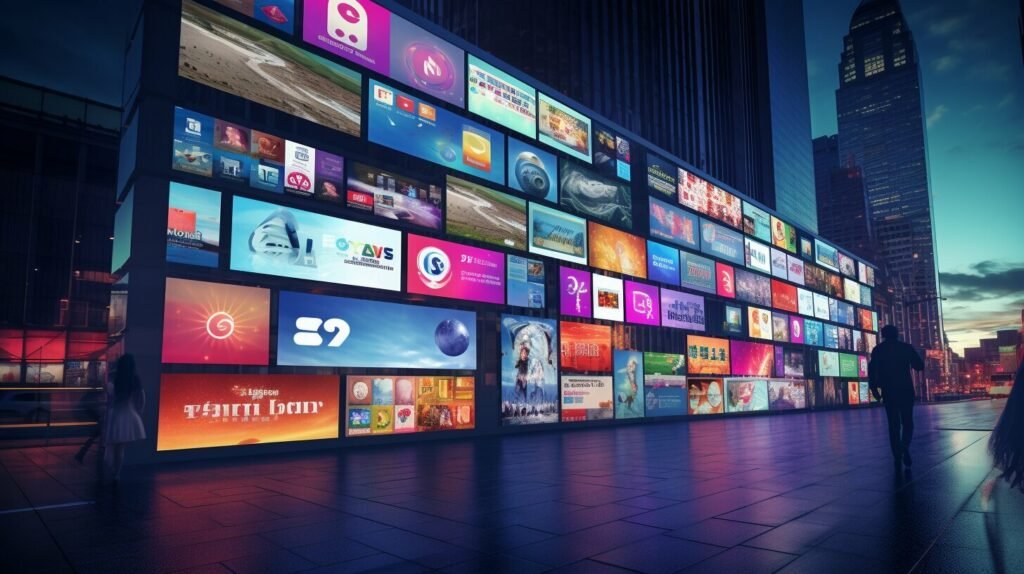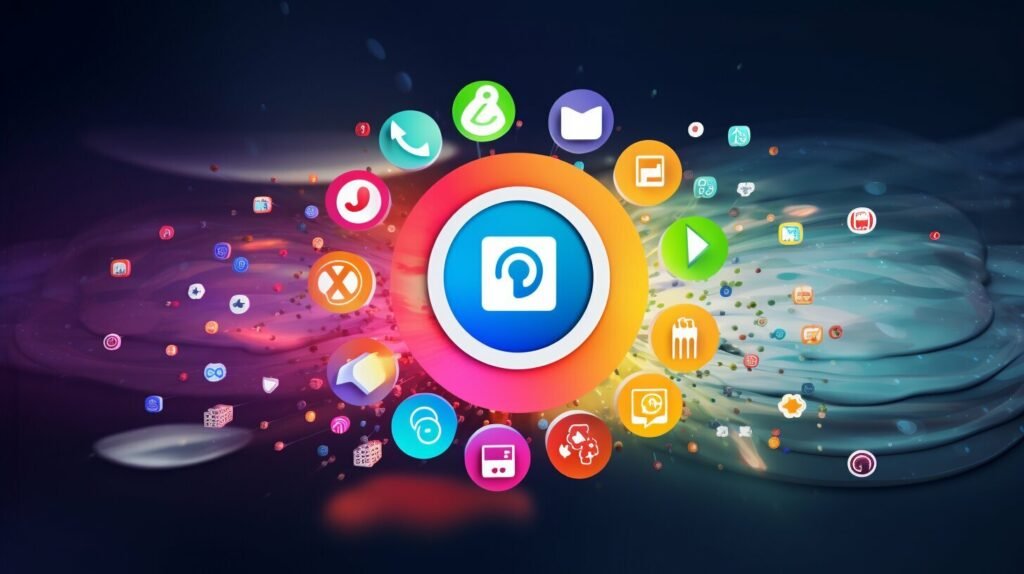Social media has revolutionized the way we interact with each other and with brands. As a result, it has also had a significant impact on advertising, particularly on below-the-line (BTL) strategies. BTL marketing tactics aim to reach consumers on a more personal level, by creating direct engagement and promoting brand awareness. With the advent of social media, BTL strategies have evolved to include digital channels that offer even more opportunities for engaging with customers.
Understanding the influence of social media on BTL strategies is essential for modern marketers. Incorporating social media into BTL campaigns can enhance brand awareness and engagement, while also increasing the potential for conversions. However, it is important to approach the integration of social media with BTL tactics with careful consideration and planning.
Key Takeaways:
- Social media has significantly impacted BTL strategies in advertising.
- Incorporating social media into BTL campaigns can enhance brand awareness and engagement.
- The integration of social media with BTL tactics should be approached with careful consideration and planning.
Understanding Below-the-Line (BTL) Strategies in the Age of Social Media.
Below-the-line (BTL) strategies are a form of advertising that targets a specific audience in a personalized, direct, and measurable manner. These strategies focus on driving immediate response and engagement from the consumer. BTL tactics are typically used to complement above-the-line (ATL) strategies, which are more general and aimed at building brand awareness.
In the age of social media, BTL strategies have evolved significantly. Marketers now have the ability to leverage a wide range of digital channels and platforms to reach their target audience in a more targeted and personalized way. Social media platforms like Facebook, Instagram, Twitter, and LinkedIn offer a wealth of data and insights that can be used to refine and optimize BTL strategies.
Effective BTL strategies in the age of social media require a deep understanding of consumer behavior and an ability to leverage technology and data to drive engagement and response. Brands must be able to create personalized experiences that resonate with their target audience. This requires a combination of creativity, technology, and data-driven insights.
Key Components of BTL Strategies
BTL strategies typically consist of several key components, including:
- Direct Mail: Personalized and targeted mail campaigns that aim to drive response and engagement.
- Events and Experiential Marketing: Engaging and immersive experiences that allow consumers to interact with a brand and its products.
- Sales Promotion: Short-term incentives such as discounts, coupons, and loyalty programs that aim to drive immediate response and engagement.
- Public Relations: Creating and distributing targeted messages to the media and influencers to build brand awareness and drive engagement.
Each of these components can be leveraged and optimized using social media and digital technologies to enhance personalized engagement with consumers.

In the age of social media, BTL strategies have evolved significantly. Marketers now have the ability to leverage a wide range of digital channels and platforms to reach their target audience in a more targeted and personalized way.
Leveraging Social Media for BTL Marketing: Key Considerations
Social media has emerged as a powerful tool to enhance below-the-line (BTL) marketing efforts. However, to effectively leverage social media, it is essential to align social media strategies with BTL objectives and understand key considerations for implementation.
| Key Considerations: | Description: |
|---|---|
| Target Audience | Identify the target audience for BTL marketing and tailor social media strategies accordingly. |
| Platform Selection | Choose social media platforms that align with BTL objectives and target audience preferences. |
| Content Strategy | Develop a content strategy that integrates with traditional BTL tactics and resonates with target audience. |
| Engagement Plan | Create a plan for engaging with the target audience through social media and align it with BTL objectives. |
| Measurement Metrics | Select metrics to track social media impact on BTL campaigns and evaluate success. |
It is important to recognize that while social media can enhance BTL strategies, it cannot replace traditional BTL tactics. Rather, effective integration of social media with traditional BTL channels can increase overall impact. For example, direct mail campaigns can be augmented with social media posts that generate buzz and encourage engagement.
Developing a cohesive multi-channel approach is key to optimizing BTL strategies with social media integration. This approach requires the alignment of social media strategies with BTL objectives, careful consideration of target audience preferences, and the integration of social media with traditional BTL tactics.
By following these key considerations, marketers can effectively leverage social media to enhance BTL marketing efforts and achieve desired results.

The Impact of Social Media on Traditional BTL Tactics
Social media has disrupted traditional below-the-line (BTL) tactics in advertising. While traditional BTL tactics such as direct mail, events, and experiential marketing are still relevant, the rise of social media has transformed the way in which these tactics are implemented.
Social media has provided new platforms and channels for marketers to engage with consumers and reach their target audience. However, incorporating social media into BTL campaigns also comes with challenges and limitations.
One of the advantages of using social media in BTL campaigns is its ability to reach a wider audience and generate buzz through social sharing. For example, a well-executed social media influencer campaign can generate a significant amount of attention and word-of-mouth marketing.
On the other hand, the use of social media in BTL campaigns can also lead to information overload and saturation. Consumers are bombarded with an overwhelming amount of content on social media, making it difficult for BTL campaigns to stand out and make an impact.
Furthermore, the use of social media in BTL campaigns requires careful consideration of timing, frequency, and tone. Overly aggressive or insensitive social media campaigns can result in backlash and damage to a brand’s reputation.
Despite these challenges, incorporating social media into traditional BTL tactics can lead to a more effective and engaging marketing campaign. By leveraging platforms like Instagram and Facebook, brands can enhance customer interaction and reach a broader audience. Furthermore, technology integration in BTL campaigns allows marketers to gather valuable data on consumer behavior, enabling them to tailor their strategies for better results. This synergy between digital and traditional methods not only amplifies brand visibility but also fosters a more personalized customer experience.

Image source: seowriting.ai
Optimizing BTL Strategies with Social Media Integration.
Integrating social media into below-the-line (BTL) strategies can significantly boost the effectiveness of marketing campaigns. However, it is essential to understand how to incorporate social media in a way that is aligned with BTL objectives and leverages the strengths of traditional BTL tactics.
Here are some key considerations for optimizing BTL strategies with social media integration:
| Consideration | Description |
|---|---|
| Target audience | Identify the target audience and choose social media platforms that align with their preferences and behavior. |
| Content | Create engaging and relevant content that resonates with the target audience and complements traditional BTL tactics. |
| Timing | Align social media activities with BTL campaigns and choose the most appropriate timing for maximum impact. |
| Metrics | Define metrics to measure the impact of social media integration and optimize campaigns based on data-driven insights. |
By following these considerations, marketers can effectively leverage social media to enhance the effectiveness of traditional BTL tactics, leading to increased engagement and higher conversion rates.
It is also important to note that effective social media integration requires a cohesive multi-channel approach, whereby social media activities are integrated seamlessly with traditional BTL tactics. This ensures a consistent and coherent message across all channels, increasing the overall impact of BTL campaigns.

Next, we will showcase real-world examples of successful BTL strategies that have effectively integrated social media, providing insights and actionable tips for marketers seeking to optimize their BTL strategies with social media integration. One example of a successful BTL strategy that integrated social media is the campaign launched by Coca-Cola for their “Share a Coke” campaign. The company encouraged customers to find and share bottles with their names on social media, resulting in a significant increase in user-generated content and a boost in brand awareness. Another example is the partnership between Red Bull and Snapchat, where the energy drink company sponsored a live Snapchat story during the X Games, reaching millions of viewers. When seeking to optimize BTL strategies with social media integration, marketers should consider questions to ask potential partners such as: “How will social media be used to complement the BTL strategy? ” and “What specific metrics will be used to measure the success of the social media integration? ” These questions can help ensure that the partnership will effectively leverage social media to achieve the desired marketing objectives.
Case Studies: Successful BTL Strategies with Social Media Integration
Real-world examples demonstrate the effectiveness of integrating social media into BTL strategies. The following case studies highlight key tactics and elements that contributed to their success. For example, a small clothing brand utilized social media platforms to engage with their audience, leading to a significant increase in sales. By creating interactive posts and running giveaways, they were able to drive traffic to their website and convert followers into paying customers. Another company, a local restaurant, saw an uptick in foot traffic and online orders after implementing a social media influencer partnership. These examples raise potential partners questions about how they can leverage social media to achieve similar results for their own businesses.
| Brand | Objectives | Strategy | Results |
|---|---|---|---|
| Ben & Jerry’s | Drive engagement and sales among Gen Z consumers | Launched a social media campaign with user-generated content featuring custom flavors and a branded hashtag. Hosted a virtual ice cream social with influencers and fans. | Generated over 38K posts with the branded hashtag and a 3.6% increase in sales among Gen Z consumers. |
| Heinz | Reinforce brand identity and loyalty among consumers | Created a social media contest for fans to design a limited edition ketchup bottle and vote on the winning design. Launched a digital billboard campaign featuring the winning design. | Over 32K submissions and 1M votes in the contest. Generated buzz and positive sentiment on social media and increased brand loyalty among consumers. |

“These case studies demonstrate the power of social media in enhancing BTL strategies. By leveraging user-generated content, branded hashtags, and influencer partnerships, these brands were able to generate buzz and drive engagement among their target audiences.”
Measuring the Impact: Evaluating the Success of Social Media in BTL Strategies
Measuring the impact of social media is essential for evaluating the success of BTL campaigns.
One key metric for measuring success is engagement. This includes likes, shares, comments, and reposts on social media platforms. A high level of engagement indicates that consumers are actively interacting with the campaign and are interested in the product or service being advertised.
Another metric is website traffic. By monitoring website traffic during a BTL campaign, marketers can determine how effective their social media efforts are in driving traffic to their website.
Conversion rate is also an important metric to track. This measures how many consumers follow through with a desired action, such as making a purchase or signing up for a service. By tracking conversion rates, marketers can determine if their social media efforts are effectively driving sales and achieving the desired ROI.
In addition to tracking these metrics, there are various tools available for measuring the impact of social media in BTL campaigns. Google Analytics, for example, can provide valuable insights into website traffic, while social media monitoring tools such as Hootsuite and Sprout Social can track engagement and brand mentions across multiple social media platforms.
It is important to note, however, that measuring the impact of social media in BTL campaigns can be challenging due to the complex nature of multi-channel marketing. Therefore, it is essential to develop a clear measurement strategy and set realistic goals and benchmarks for success.

Challenges and Limitations of Social Media in BTL Strategies
While social media can be a powerful tool in BTL strategies, it is not without its challenges and limitations. One major challenge is the saturation of social media platforms, which can make it difficult to stand out in a crowded market. Additionally, social media algorithms constantly change, making it difficult to keep up with the latest trends and strategies.
Another limitation is the potential for negative feedback and backlash. Social media users are quick to call out brands for unethical or insensitive behavior, and this can have a significant impact on a company’s reputation. It is essential to carefully consider the content posted on social media and ensure it aligns with ethical and legal standards.
Furthermore, social media can also be a time-consuming and resource-intensive endeavor. Maintaining an active social media presence requires a significant investment of time and resources, which may not be feasible for all companies. It is essential to weigh the potential benefits against the costs before committing to a social media strategy.
Despite these challenges and limitations, social media remains a valuable tool in BTL strategies when used effectively. Brands that take the time to develop a well-crafted social media strategy and carefully consider the potential risks and benefits can successfully leverage this powerful marketing tool to drive engagement and increase brand awareness.

Future Trends: Evolving BTL Strategies in the Age of Social Media
The continued growth and evolution of social media has led to significant changes in marketing tactics, and below-the-line (BTL) strategies are no exception. As consumer behavior shifts towards digital channels, marketers must adapt their BTL tactics to leverage the power of social media.
Emerging technologies such as augmented reality and virtual reality are becoming increasingly prevalent in BTL campaigns. These technologies provide immersive experiences that can engage consumers on a deeper level, creating a highly memorable and impactful experience. In addition, personalization and targeted advertising are quickly becoming the norm, with highly specific and personalized messaging that resonates with individual consumers.
Another key trend in BTL strategies is the integration of social media with traditional tactics. As discussed in previous sections, social media can be leveraged to enhance the impact of events, direct mail, and experiential marketing. By combining social media with traditional channels, marketers can create a cohesive multi-channel approach that reaches consumers through a variety of touchpoints.
The rise of social media influencers is also shaping the future of BTL strategies. Influencers have the ability to reach a highly targeted and engaged audience, making them a valuable asset for BTL campaigns. By partnering with influencers who align with their brand values and messaging, marketers can extend the reach of their BTL efforts and create a more authentic and relatable message.
However, with these new opportunities come new challenges. Maintaining compliance and upholding ethical standards is becoming increasingly complex, with regulations and guidelines constantly evolving. Marketers must remain vigilant and ensure that their BTL strategies are not only effective but also legal and ethical.
Overall, the future of BTL strategies in the age of social media is exciting and full of potential. By staying up to date with emerging technologies and consumer trends, and by maintaining ethical practices, marketers can continue to evolve their BTL campaigns and stay ahead of the curve.

Effective Integration: Social Media and Traditional BTL Channels
In the digital age, marketers must take a holistic approach to advertising that incorporates both traditional below-the-line (BTL) tactics and social media strategies. By effectively integrating social media with traditional BTL channels, marketers can amplify the reach and impact of their campaigns while creating a cohesive multi-channel approach.
Direct Mail:
Direct mail campaigns have long been a staple of BTL strategies, offering a personalized touch and tangible experience for consumers. When incorporating social media into direct mail campaigns, consider including a call-to-action that directs recipients to a social media page or group related to the campaign. This can further engage consumers and promote a sense of community around the campaign.
Events:
Events provide a unique opportunity to connect with consumers in person, but incorporating social media into event marketing can expand the reach of the campaign beyond the event itself. Encourage attendees to use a specific hashtag when posting about the event on social media, and consider incorporating live social media feeds or interactive experiences at the event that encourage engagement and sharing.
Experiential Marketing:
Experiential marketing aims to create immersive, memorable experiences for consumers. Social media can enhance the impact of experiential marketing by providing a platform for user-generated content and social sharing. Consider incorporating social media elements into experiential campaigns, such as photo opportunities with branded props or a social media contest tied to the campaign.

By effectively integrating social media with traditional BTL channels, marketers can create a multi-channel approach that delivers a cohesive brand message and maximizes the impact of campaigns. To ensure the success of social media integration, marketers should align social media strategies with BTL objectives, craft engaging content, and monitor and adjust campaigns in response to consumer behavior.
Ensuring Compliance: Legal and Ethical Considerations in Social Media BTL Strategies
As with any marketing strategy, there are legal and ethical considerations that must be taken into account when using social media in below-the-line (BTL) strategies. While social media provides a powerful platform for reaching customers and engaging with them on a personal level, it is important to adhere to regulations and best practices to avoid legal issues and maintain ethical standards.
One of the key considerations in social media BTL strategies is compliance with industry regulations. Advertisers must be aware of the guidelines set forth by regulatory bodies such as the Federal Trade Commission (FTC) and ensure that their social media campaigns are in line with these regulations. For example, the FTC requires that sponsored content be clearly and conspicuously labeled as such.

Another important consideration is respecting the privacy of customers and their personal data. Advertisers must be transparent about the data they collect and how it is used, and provide customers with the opportunity to opt-out of data collection and marketing communication.
Furthermore, it is essential to maintain ethical standards in social media BTL strategies. Advertisers must avoid deceptive or misleading content, and ensure that their campaigns are respectful and appropriate. This includes avoiding offensive or discriminatory language or imagery, and respecting cultural differences and sensitivities.
Overall, ensuring compliance with legal and ethical standards is crucial in social media BTL strategies. Adhering to regulations and best practices not only avoids legal issues, but also builds trust with customers and strengthens brand reputation.
Conclusion
As social media continues to shape modern marketing tactics, it’s important for marketers to understand the impact it has on below-the-line strategies. Through effective integration of social media with traditional BTL channels, marketers can optimize their campaigns for maximum impact.
Successful BTL strategies with social media integration require careful consideration of key metrics, legal and ethical considerations, and continuous adaptation to changing consumer behavior. While challenges and limitations exist, the potential benefits of social media in BTL marketing cannot be ignored.
As we look towards the future of BTL strategies, it’s clear that social media will continue to play a significant role in driving engagement and brand awareness. By staying up-to-date on emerging technologies and continuously measuring the impact of social media integration, marketers can stay ahead of the curve and remain competitive in a rapidly evolving marketing landscape.
How Can Socially Responsible BTL Practices Be Incorporated into Social Media Strategies?
Social media strategies can embrace sustainable btl practices for social responsibility by integrating eco-friendly initiatives. Brands can create impactful content to raise awareness about important causes, support environmental campaigns, and promote responsible consumer behavior. Effective social media campaigns can educate and encourage individuals to adopt sustainable practices, minimizing their ecological footprint and fostering a more socially responsible society.
FAQ
Q: What is the influence of social media on BTL strategies?
A: Social media has a significant impact on below-the-line (BTL) strategies in advertising. It has transformed traditional BTL tactics and provides new opportunities for marketers to engage with their target audience.
Q: How have BTL strategies evolved in the age of social media?
A: BTL strategies have evolved to incorporate social media as a key component. Marketers now leverage social media platforms to enhance their BTL marketing efforts and reach a wider audience.
Q: How can social media be leveraged for BTL marketing?
A: To leverage social media for BTL marketing, it is important to align social media strategies with BTL objectives. Marketers should consider the target audience, platform selection, content creation, and engagement tactics.
Q: What is the impact of social media on traditional BTL tactics?
A: Social media has influenced and transformed traditional BTL tactics by providing new channels for communication and customer engagement. It allows for real-time interaction, personalization, and the ability to track and measure campaign effectiveness.
Q: How can BTL strategies be optimized with social media integration?
A: By integrating social media into BTL strategies, marketers can optimize their campaigns for maximum impact. This can be achieved by creating cohesive multi-channel campaigns, leveraging social media for targeted messaging, and utilizing data analytics for performance measurement.
Q: Can you provide examples of successful BTL strategies with social media integration?
A: Yes, there are numerous successful BTL strategies that have effectively integrated social media. Some examples include interactive social media contests, influencer collaborations, and user-generated content campaigns.
Q: How can the impact of social media in BTL strategies be measured?
A: The impact of social media in BTL strategies can be measured through key metrics such as engagement rates, reach, conversions, and brand sentiment analysis. Various tools and analytics platforms are available to track and evaluate social media performance.
Q: What are the challenges and limitations of using social media in BTL strategies?
A: Challenges of using social media in BTL strategies include managing online reputation, handling negative feedback, ensuring compliance with legal and ethical standards, and staying updated with ever-changing social media algorithms.
Q: What are the future trends in BTL strategies in the age of social media?
A: Future trends in BTL strategies include the integration of emerging technologies such as augmented reality and virtual reality, personalized messaging through AI-powered chatbots, and the rise of influencer marketing.
Q: How can social media be effectively integrated with traditional BTL channels?
A: Social media can be effectively integrated with traditional BTL channels by creating a cohesive multi-channel approach. This involves aligning messaging, branding, and promotional activities across platforms such as direct mail, events, and experiential marketing.
Q: What legal and ethical considerations should be taken into account in social media BTL strategies?
A: Marketers should ensure compliance with legal and ethical standards when incorporating social media into BTL strategies. This includes respecting user privacy, disclosing sponsored content, and adhering to regulations such as the General Data Protection Regulation (GDPR).





